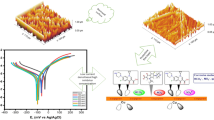Abstract
In this research, absorbents for CO2 capture were prepared by blending 30 wt% potassium carbonate, 3 wt% of a rate promoter, and 1 wt% of a corrosion inhibitor. Pipecolic acid, sarcosine, and diethanolamine were chosen as rate promoter candidates. Based on a rate promoter screening test for CO2 loading capacity and absorption rate, pipecolic acid and sarcosine were selected to be used as rate promoters. 1,2,3-benzotriazole and ammonium thiocyanate were chosen as corrosion inhibitors, and they were mixed with a 30 wt% potassium carbonate-based absorbent mixture containing one of the rate promoters. The absorption rates for four absorbent solutions (30 wt% potassium carbonate + 3 wt% pipecolic acid + 1 wt% 1,2,3-benzotriazole, 30 wt% potassium carbonate + 3 wt% pipecolic acid + 1 wt% ammonium thiocyanate, 30 wt% potassium carbonate + 3 wt% sarcosine + 1 wt% 1,2,3-benzotriazole, and 30 wt% potassium carbonate + 3 wt% sarcosine + 1 wt% ammonium thiocyanate) were measured, tabulated, and graphically displayed. These types of absorbents can be used for capturing CO2 under high temperature and pressure conditions, such as those found in coal-fired power plants.










Similar content being viewed by others
References
Houghton JT, Jenkins GJ, Ephraums JJ (eds) (1990) Climate change: the IPCC scientific assessment. Cambridge University Press, Cambridge
Abu Z, Mohammad RM, Niederer JPM, Feron PHM, Versteeg GF (2007) CO2 capture from power plants: part I. A parametric study of the technical performance based on mono-ethanolamine. Int J Greenh Gas Control 1(2):135–142
Song HJ, Park SW, Kim H, Gaur A, Park JW, Lee SJ (2012) Carbon dioxide absorption characteristics of aqueous amino acid salt solutions. Int J Greenh Gas Control 11:64–72
Ramazani R, Mazinani S, Jahanmiri A, Bruggen V (2016) Experimental investigation of the effect of addition of different activators to aqueous solutions of potassium carbonate: absorption rate and solubility. Int J Greenh Gas Control 45:27–33
Hu G, Nicholas NJ, Smith KH, Mumford KA, Kentish SE, Stevens GW (2016) Carbon dioxide absorption into promoted potassium carbonate solutions: a review. Int J Greenh Gas Control 53:28–40
Kang D, Park S, Jo H, Min J, Park J (2013) Solubility of CO2 in amino-acid-based solutions of (potassium sarcosinate), (potassium alaninate + piperazine), and (potassium serinate + piperazine). J Chem Eng Data 58(6):1787–1791
Lee MG, Park S, Jo H, Kang D, Song HJ, Park J (2014) Effect of organic inhibitors in aqueous potassium carbonate on the corrosion of carbon steel. J Chem Eng Jpn 47(6):457–462
Park S, Song H, Lee M, Park J (2014) Screening test for aqueous solvents used in CO2 capture: K2CO3 used with twelve different rate promoters. Korean J Chem Eng 31:125–131
Lee M–G, Kang D, Jo H, Park J (2016) Carbon dioxide utilization with carbonation using industrial waste-desulfurization gypsum and waste concrete. J Mater Cycles Waste Manag 18:407–412
Kang D, Jo H, Lee M-G, Park J (2016) Carbon dioxide utilization using a pretreated brine solution at normal temperature and pressure. Chem Eng J 284:1270–1278
Kang D, Lee M-G, Jo H, Yoo Y, Lee S-Y, Park J (2017) Carbon capture and utilization using industrial wastewater under ambient conditions. Chem Eng J 308:1073–1080
Saidi M, Heidarinejad S, Rahimpour HR, Talaghat MR, Rahimpour MR (2014) Mathematical modeling of carbon dioxide removal using amine-promoted hot potassium carbonate in a hollow fiber membrane contactor. J Nat Gas Sci Eng 18:274–285
Kim YE, Choi JH, Nam SC, Yoon YI (2012) CO2 absorption capacity using aqueous potassium carbonate with 2-methylpiperazine and piperazine. J Ind Eng Chem 18(1):105–110
Song HJ, Lee MG, Kim HT, Gaur A, Park JW, Density (2011) Viscosity, heat capacity, surface tension, and solubility of CO2 in aqueous solutions of potassium serinate. J Chem Eng Data 56:1371–1377
Gondal S, Asif N, Svendsen HF, Knuutila H (2015) Kinetics of the absorption of carbon dioxide into aqueous hydroxides of lithium, sodium and potassium and blends of hydroxides and carbonates. Chem Eng Sci 123:487–499
Shen S, Feng X, Zhao R, Ghosh UK, Chen A (2013) Kinetic study of carbon dioxide absorption with aqueous potassium carbonate promoted by arginine. Chem Eng J 222:478–487
Acknowledgements
This research was supported by the Human Resources Program in Energy Technology of the Korea Institute of Energy Technology Evaluation and Planning (KETEP), granted financial resource from the Ministry of Trade, Industry & Energy, Republic of Korea (no. 20174010201640), and also supported by Global Ph.D. Fellowship Program through the National Research Foundation of Korea (NRF) funded by the Ministry of Education (NRF-2014H1A2A1021595).
Author information
Authors and Affiliations
Corresponding author
Rights and permissions
About this article
Cite this article
Kang, D., Lee, MG., Yoo, Y. et al. Absorption characteristics of potassium carbonate-based solutions with rate promoters and corrosion inhibitors. J Mater Cycles Waste Manag 20, 1562–1573 (2018). https://doi.org/10.1007/s10163-018-0719-4
Received:
Accepted:
Published:
Issue Date:
DOI: https://doi.org/10.1007/s10163-018-0719-4




